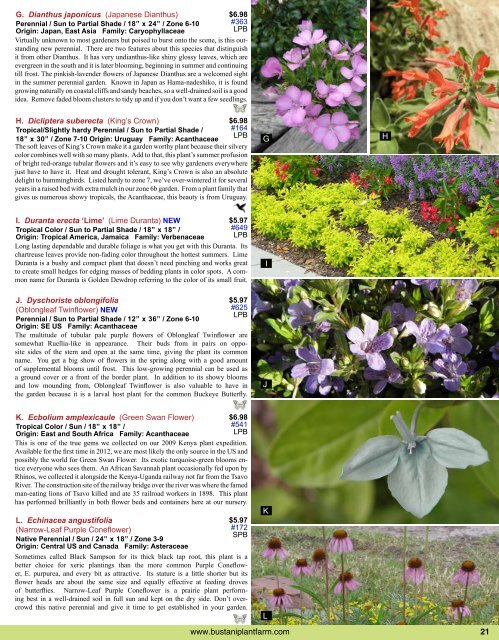Download Catalog - Bustani Plant Farm
Download Catalog - Bustani Plant Farm
Download Catalog - Bustani Plant Farm
You also want an ePaper? Increase the reach of your titles
YUMPU automatically turns print PDFs into web optimized ePapers that Google loves.
G. Dianthus japonicus (Japanese Dianthus)<br />
Perennial / Sun to Partial Shade / 18” x 24” / Zone 6-10<br />
Origin: Japan, East Asia Family: Caryophyllaceae<br />
Virtually unknown to most gardeners but poised to burst onto the scene, is this outstanding<br />
new perennial. There are two features about this species that distinguish<br />
it from other Dianthus. It has very undianthus-like shiny glossy leaves, which are<br />
evergreen in the south and it is later blooming, beginning in summer and continuing<br />
till frost. The pinkish-lavender flowers of Japanese Dianthus are a welcomed sight<br />
in the summer perennial garden. Known in Japan as Hama-nadeshiko, it is found<br />
growing naturally on coastal cliffs and sandy beaches, so a well-drained soil is a good<br />
idea. Remove faded bloom clusters to tidy up and if you don’t want a few seedlings.<br />
H. Dicliptera suberecta (King’s Crown)<br />
Tropical/Slightly hardy Perennial / Sun to Partial Shade /<br />
18” x 30” / Zone 7-10 Origin: Uruguay Family: Acanthaceae<br />
$6.98<br />
#363<br />
LPB<br />
The soft leaves of King’s Crown make it a garden worthy plant because their silvery<br />
color combines well with so many plants. Add to that, this plant’s summer profusion<br />
of bright red-orange tubular flowers and it’s easy to see why gardeners everywhere<br />
just have to have it. Heat and drought tolerant, King’s Crown is also an absolute<br />
delight to hummingbirds. Listed hardy to zone 7, we’ve over-wintered it for several<br />
years in a raised bed with extra mulch in our zone 6b garden. From a plant family that<br />
gives us numerous showy tropicals, the Acanthaceae, this beauty is from Uruguay.<br />
I. Duranta erecta ‘Lime’ (Lime Duranta) NEW<br />
Tropical Color / Sun to Partial Shade / 18” x 18” /<br />
Origin: Tropical America, Jamaica Family: Verbenaceae<br />
$6.98<br />
#164<br />
LPB<br />
Long lasting dependable and durable foliage is what you get with this Duranta. Its<br />
chartreuse leaves provide non-fading color throughout the hottest summers. Lime<br />
Duranta is a bushy and compact plant that doesn’t need pinching and works great<br />
to create small hedges for edging masses of bedding plants in color spots. A common<br />
name for Duranta is Golden Dewdrop referring to the color of its small fruit.<br />
J. Dyschoriste oblongifolia<br />
(Oblongleaf Twinflower) NEW<br />
Perennial / Sun to Partial Shade / 12” x 36” / Zone 6-10<br />
Origin: SE US Family: Acanthaceae<br />
$5.97<br />
#649<br />
LPB<br />
The multitude of tubular pale purple flowers of Oblongleaf Twinflower are<br />
somewhat Ruellia-like in appearance. Their buds from in pairs on opposite<br />
sides of the stem and open at the same time, giving the plant its common<br />
name. You get a big show of flowers in the spring along with a good amount<br />
of supplemental blooms until frost. This low-growing perennial can be used as<br />
a ground cover or a front of the border plant. In addition to its showy blooms<br />
and low mounding from, Oblongleaf Twinflower is also valuable to have in<br />
the garden because it is a larval host plant for the common Buckeye Butterfly.<br />
K. Ecbolium amplexicaule (Green Swan Flower)<br />
Tropical Color / Sun / 18” x 18” /<br />
Origin: East and South Africa Family: Acanthaceae<br />
$5.97<br />
#625<br />
LPB<br />
This is one of the true gems we collected on our 2009 Kenya plant expedition.<br />
Available for the first time in 2012, we are most likely the only source in the US and<br />
possibly the world for Green Swan Flower. Its exotic turquoise-green blooms entice<br />
everyone who sees them. An African Savannah plant occasionally fed upon by<br />
Rhinos, we collected it alongside the Kenya-Uganda railway not far from the Tsavo<br />
River. The construction site of the railway bridge over the river was where the famed<br />
man-eating lions of Tsavo killed and ate 35 railroad workers in 1898. This plant<br />
has performed brilliantly in both flower beds and containers here at our nursery.<br />
L. Echinacea angustifolia<br />
(Narrow-Leaf Purple Coneflower)<br />
Native Perennial / Sun / 24” x 18” / Zone 3-9<br />
Origin: Central US and Canada Family: Asteraceae<br />
$6.98<br />
#541<br />
LPB<br />
$5.97<br />
#172<br />
SPB<br />
Sometimes called Black Sampson for its thick black tap root, this plant is a<br />
better choice for xeric plantings than the more common Purple Coneflower,<br />
E. purpurea, and every bit as attractive. Its stature is a little shorter but its<br />
flower heads are about the same size and equally effective at feeding droves<br />
of butterflies. Narrow-Leaf Purple Coneflower is a prairie plant performing<br />
best in a well-drained soil in full sun and kept on the dry side. Don’t overcrowd<br />
this native perennial and give it time to get established in your garden.<br />
G<br />
I<br />
J<br />
K<br />
L<br />
www.bustaniplantfarm.com 21<br />
H


